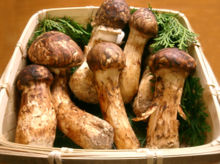Matsutake
| Matsutake | |
|---|---|

| |
| Matsutake | |
Conservation status
| |
| Scientific classification | |
| Kingdom: | Fungi |
| Division: | Basidiomycota |
| Class: | Agaricomycetes |
| Order: | Agaricales |
| Family: | Tricholomataceae |
| Genus: | Tricholoma |
| Species: | T. matsutake
|
| Binomial name | |
| Tricholoma matsutake | |
| Synonyms | |
| Tricholoma matsutake Mycological characteristics | |
|---|---|
| gills on hymenium | |
| cap is convex | |
| hymenium is adnexed | |
| stipe has a ring | |
| spore print is white | |
| ecology is mycorrhizal | |
| edibility: choice | |
| Matsutake | |||
|---|---|---|---|
| Chinese name | |||
| Traditional Chinese | 松茸 | ||
| Simplified Chinese | 松茸 | ||
| Literal meaning | pine down | ||
| |||
| Korean name | |||
| Hangul | 송이 | ||
| Hanja | 松栮 | ||
| |||
| Japanese name | |||
| Kanji | 松茸 | ||
| Hiragana | まつたけ | ||
| Katakana | マツタケ | ||
| |||
Matsutake (Japanese: 松茸), Chinese: 松茸 Tricholoma matsutake, is a highly sought species of choice edible mycorrhizal mushroom that grows in East Asia, Europe, and North America. It is prized in Japanese cuisine for its distinct spicy-aromatic odor.[3][4]
It is a luxurious ingredient in Japan, and the Japanese have preferred matsutake as an ingredient since the Neolithic period.[5] However, non-Japanese people often perceive the scent of matsutake as an "unpleasant odor," and until recently, matsutake mushrooms were not considered a food ingredient in most parts of the world, including China and Korea.[6]
Habitat and distribution[]
Matsutake mushrooms grow under trees and are usually concealed under litter on the forest floor, forming a symbiotic relationship with roots of various tree species.
Matsutake mushrooms grow in East Asia, Southeast Asia (Bhutan and Laos), parts of Europe such as Estonia, Finland, Norway, Poland, and Sweden; and along the Pacific coasts of Canada and the United States.
In Korea and Japan, matsutake mushrooms are most commonly associated with Pinus densiflora.[7]
Similar species[]
In the North American Pacific Northwest, Tricholoma murrillianum is found in coniferous forests of one or more of the following tree species: Douglas fir, Noble fir, Shasta red fir, Sugar pine, Ponderosa pine, or Lodgepole pine. In California and parts of Oregon, it is also associated with hardwoods, including Tanoak, Madrone, Rhododendron, Salal, and Manzanita.[citation needed] In northeastern North America, the closely related mushroom Tricholoma magnivelare is generally found in Jack pine forests.[8] A report published in 2000 indicated that Tricholoma nauseosum and matsutake (T. matsutake) are the same species.[9]
Cost and availability[]
Matsutake are hard to find because of their specific growth requirements, the rarity of appropriate forest and terrain and competition from wild animals such as squirrel, rabbits and deer for the once-yearly harvest of mushrooms. Domestic production of matsutake in Japan has also been sharply reduced over the last 50 years due to the pine-killing nematode Bursaphelenchus xylophilus, and the annual harvest of matsutake in Japan is now less than 1,000 tons, with the Japanese mushroom supply largely made up by imports from China, Korea, the Pacific Northwest, British Columbia, and northern Europe.[10] This results in prices in the Japanese market highly dependent on quality, availability, and origin that can range from as high as $1,000 per kilogram for domestically harvested matsutake at the beginning of the season to as low as $4.41 per kilogram ($2 per pound), though the average value for imported matsutake is about $90 per kilogram.[11]
See also[]
- Himematsutake: the "princess matsutake"
- List of Tricholoma species
- Medicinal fungi
- The Mushroom at the End of the World by Anna Tsing
References[]
- ^ Brandrud, T.-E. (2020). Tricholoma matsutake. The IUCN Red List of Threatened Species 2020: e.T76267712A76268018. Downloaded on 09 July 2020.
- ^ Jump up to: a b c "Tricholoma matsutake (S.Ito & S.Imai) Singer". www.gbif.org.
- ^ Ashkenazi, Michael; Jacob, Jeanne (2003). Food culture in Japan. Greenwood Publishing Group. p. 49. ISBN 978-0-313-32438-3.
- ^ "Play That Fungi Music". Archived from the original on May 17, 2010.
- ^ 日本特用林産振興会「きのこの食文化」2018年8月20日閲覧
- ^ 【ニュースの門】山肥えて マツタケ消ゆる秋『読売新聞』朝刊2020年10月11日(解説面)
- ^ Ashburne, John, "In search of the Holy Grail of mushrooms", The Japan Times, 16 October 2011, p. 7.
- ^ Trudell, Steven A.; Xu, Jianping; Saar, Irja; Justo, Alfredo; Cifuentes, Joaquin (May 2017). "North American matsutake: names clarified and a new species described". Mycologia. 109 (3): 379–390. doi:10.1080/00275514.2017.1326780. ISSN 0027-5514. PMID 28609221. S2CID 205448035.
- ^ Bergius, Niclas; Danell, Eric (5 November 2000). "The Swedish matsutake (Tricholoma nauseosum syn. T. matsutake): Distribution, Abundance and Ecology". Scandinavian Journal of Forest Research. 15 (3): 318–325. doi:10.1080/028275800447940. S2CID 83741330.
- ^ (in Japanese) 輸入マツタケに異変 中国産激減、フィンランド参戦, J-CAST, 2007/9/26.
- ^ Matsutani, Minoru, "Japan's long love affair with 'matsutake'", The Japan Times, 9 November 2010, p. 3.
External links[]
 Media related to Tricholoma matsutake at Wikimedia Commons
Media related to Tricholoma matsutake at Wikimedia Commons
- IUCN Red List vulnerable species
- East Asian cuisine
- Edible fungi
- Japanese cuisine terms
- Non-timber forest products
- Tricholoma
